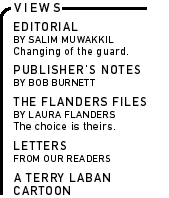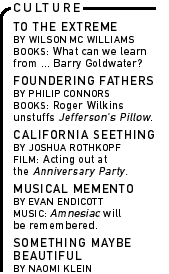

|

|

|

|
|
|
| |
|
|
|
Timothy McVeigh called it a "state-assisted suicide." That's how he viewed his own execution by lethal injection at the federal prison in Terre Haute, Indiana. McVeigh's execution will not numb the pain of the 168 senseless deaths on April 19, 1995, when a massive bomb destroyed the Alfred P. Murrah federal building in Oklahoma City. It will not deter other acts of terrorism. Nor will it put an end to lingering uncertainties about the massacre. There are too many loose ends and unanswered questions for McVeigh's execution to qualify as the end of anything. Federal officials insist that McVeigh had only one accomplice, Terry Nichols, who is facing life in prison for his ancillary role in the bomb plot. The FBI says it found no evidence of a wider conspiracy, even though the original indictment cited McVeigh, Nichols and "others unknown." The government's case, as it stands, is flawed. For starters, it's highly unlikely that McVeigh could have mixed the fertilizer bomb by himself on the day before the attack, as federal prosecutors contend. Charles Farley, a car mechanic, testified at the Nichols trial that he saw five men gathered around a Ryder truck and other vehicles near Geary State Lake, loading white bags of powder that he thought was ammonium nitrate fertilizer, the same type used in the bomb. Farley, a solid witness, had provided an exact and detailed account of what he had seen to the FBI, but the bureau inexplicably did not pursue this lead. Numerous eyewitnesses placed McVeigh in the company of other people in the days
Toward the end of his military service, McVeigh got involved with a far-right crowd with extreme, anti-government views. It was the early '90s, and the militia scene was starting to percolate. Nourished by the odoriferous compost of paranoia and hate that has long moldered on the American margins, McVeigh began making the rounds at gun shows. McVeigh immersed himself in the so-called "patriot movement," a volatile subculture where the militias overlapped with the crazed racist fringe. He joined a Ku Klux Klan group, read the Liberty Lobby's Spotlight and mingled with members of the neo-Nazi National Alliance, whose leader, William Pierce, wrote The Turner Diaries. This notorious hate novel describes a successful paramilitary insurgency by white supremacists who blow up a federal building in Washington. It was McVeigh's favorite book, and it would serve as a blueprint for the Oklahoma City bombing. A paranoid style has always been part of the U.S. political scene, along with right-wing paramilitary groups such as the KKK, the Minutemen, and the Posse Comitatus. What distinguished the post-Cold-War patriot movement from its predecessors was how it reinvented fascist ideology in a uniquely American way by combining muddled arguments for anti-big- government constitutionalism with traditional isolationist appeals, reactionary conspiracy theories and frontier myths that promised national regeneration through violence. Offering scapegoats rather than solutions, the patriot subculture attracted deeply disenchanted individuals with real, down-home gripes. Shunted aside while U.S. corporations got leaner and meaner, many of these people were treading water economically and aching for someone to blame. With so many Americans taking the paramilitary oath, wacky ideas began trickling down to millions of malcontents. The militias were rife with wild rumors about government mind-control plots, Midwest tornados caused by CIA weather modification, secret markings encoded on the backs of road-signs to assist an imminent U.N. invasion. After the Ruby Ridge shootout and the Waco conflagration, McVeigh became convinced that the federal government was plotting to disarm gun owners in order to pave the way for a takeover by a shadowy elite of bankers, industrialists and politicians who ruled the new world order. McVeigh decided to go on the offensive, hoping to spark an insurrection. It is possible that he had help from the underground Aryan Republican Army (ARA), a small group of gangsters and neo-Nazi zealots who sought to overthrow the U.S. government, purge the country of blacks and Jews, and install a new legal system based entirely on their own racist interpretation of the Bible. In the mid-'90s, the ARA robbed 22 banks in eight Midwest states. Not without a sense of humor, the ARA bandits wore whimsical disguises, such as Count Dracula and Ronald Reagan masks, while they pulled off their bank heists. Some of the stolen money may have financed McVeigh, who seemed to have an inordinate amount of cash for an unemployed drifter. During this period, McVeigh told his sister Jennifer that he had helped organize a bank robbery and he showed her a wad of $100 bills, which he claimed was payment for his role in the job. Richard Guthrie, an ARA bank robber who committed suicide in jail, referred in his unpublished memoirs to an accomplice named Tim. Indiana State University criminologist Mark Hamm has discovered a compelling connection between McVeigh's movements in the months leading up to the Oklahoma City bombing and the shifting whereabouts of the self-styled ARA guerrillas. They traveled in the same circles and were often in the same place at the same time--a pattern that is difficult to write off as mere coincidence. The ARA used Elohim City, a remote, white supremacist enclave in eastern Oklahoma, as a gathering point. McVeigh got a speeding ticket a few miles from Elohim City, and telephone logs indicate that he called the compound two weeks before the Oklahoma City attack. Carol Howe, a paid undercover informant for the Bureau of Alcohol, Tobacco and Firearms, later testified under oath that she saw McVeigh (a.k.a. "Tim Tuttle") at Elohim City. She also claimed that she heard people at Elohim City talking about bombing government buildings, but she weakened her credibility by changing parts of her story on different occasions. All known ARA members are either dead or in prison, and their role,
if any, in the Oklahoma City massacre remains a mystery. But there
are those who still believe that the only way to right deep-rooted
wrongs is by setting a timer or pulling a trigger. The subculture
of hate that spawned McVeigh has survived his execution. Martin A. Lee is the author of The Beast Reawakens, a book on neofascism.
|


